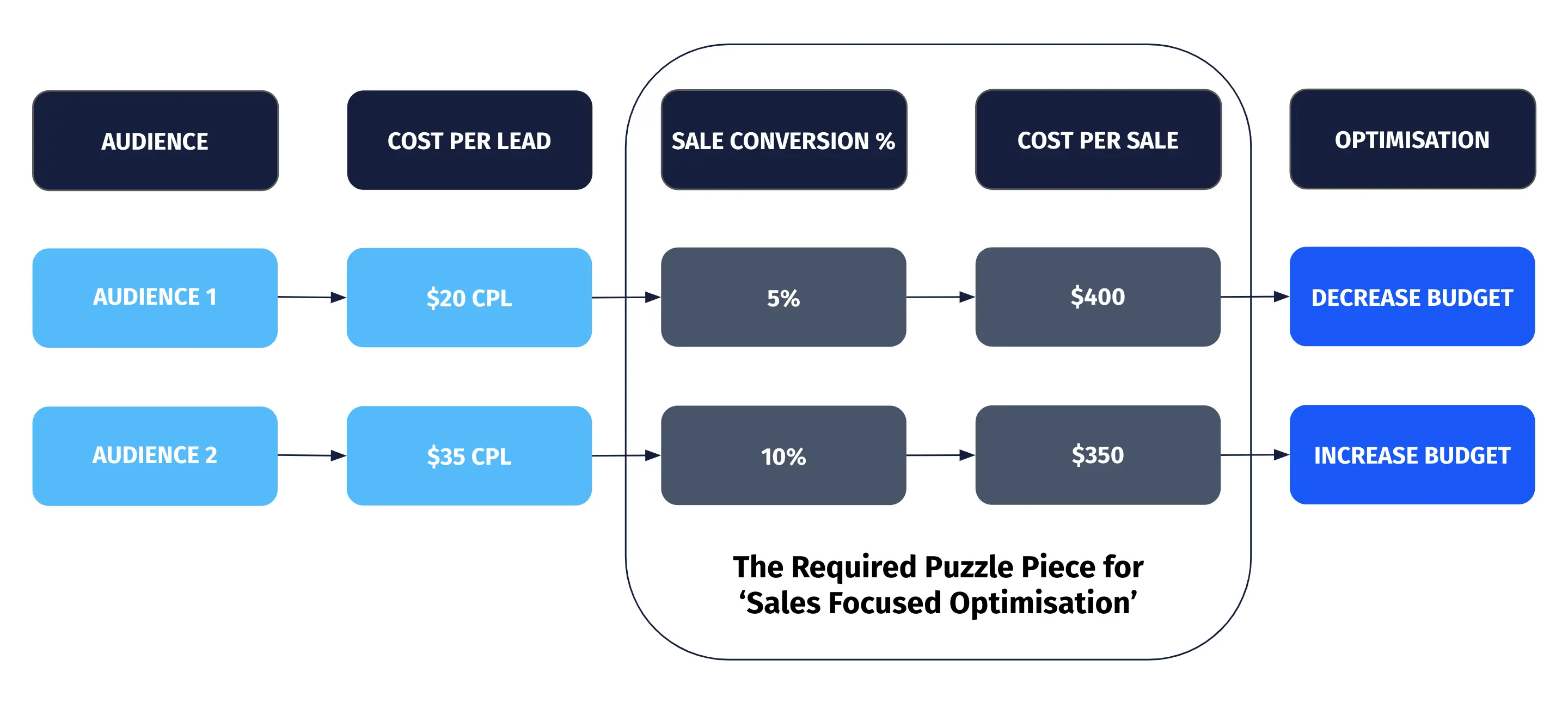“We just need more leads”… “Where are the cheaper leads?”… “How can we drive volume?”
These are statements that we regularly hear inside the agency.
And it makes sense; our clients are keen to generate predictable growth for their organisations.
However, it highlights a weakness in how many marketing teams and their agencies think about what’s required to generate tangible business results.
How Most Agencies Optimise Campaigns
In our experience, the majority of direct response agencies with a performance focus optimise their campaigns for lowest cost leads.
This approach means the distribution of advertising budget towards campaigns, offers, audiences and creative elements that generate the cheapest leads.

As shown in the graphic above, under a traditional performance-focused optimisation approach, Audience 1 would receive more budget due to the lower CPL ($20 versus $35).
Remember this scenario, as we will come back to it!
Whilst this campaign approach is undoubtedly superior to ‘branding’ or ‘traffic’ campaigns, it ignores a pivotal piece of the ROI puzzle… sales!
Why ‘More Leads’ Is Not Always Better
Over the last few years, we have become more deeply ingrained in the sales performance of our leads.
Through a better understanding of lead performance, we have confirmed our suspicion that more, lower-cost leads are not always better.
The reasons for this, which became apparent, are discussed below.
Lower Cost Tends To Correlate With Lower Quality
Campaign approaches and offers that remove ‘friction’ from the conversion process also remove an element of commitment or ‘qualification’.
An excellent example of this is the use of Facebook Lead Forms versus a landing page to capture leads.
Facebook Lead Forms remove the friction, allowing somebody to enquire in as little as two taps with pre-populated data.
Whereas, landing pages require a user to leave the Facebook environment, load a new page, and enter their details into a form.
Our testing has shown that landing page leads convert at a significantly higher rate than leads captured via Facebook Lead Forms.
Campaign success requires a balancing act that accounts for both lead quality and cost.
High Lead Volumes Require Significant Time Investment By Sales Teams
Leads are only as good as their follow-up.
As discussed in our Inbound Lead Management Best Practices Guide, sales teams must follow up leads quickly and persistently.
Unfortunately, valuable sales team member time spent following up high volumes of low-quality leads can represent a high cost to many companies.
It also reduces the time available to sales team members for high-value activities directed at qualified prospects deeper in the conversion process.
Both will be detrimental to performance and represent a hit to any campaign’s return on investment.
Low Conversion Rates Can Crush Your Sales Team’s Morale
Success in sales requires confidence.
It’s a tough gig, sales. You hear more no’s than yes’s but you have to keep going, keep dialling, keep closing!
However, despite what you might think, salespeople are human too.
The generation of high volumes of low-quality, low-cost leads will reduce the success of your sales team. They will have higher rates of non-contact and disqualification of leads.
These repeated failures can become quite demoralising and demotivating.
Unfortunately, in a vicious cycle, this can result in further reductions in sales performance and productivity.
Increased Opportunities For Negative Experiences
A strategy that results in the generation of high volumes of low-quality low-cost lead means that your company will come into contact with more people every day.
Further, as discussed above, your team will be disqualifying more leads based on their lack of fit for what you do.
This strategy increases the opportunities for somebody to have a negative experience with your company. We’ve seen this vary from the benign (think: “Too big/small/expensive”) to the potentially damaging (think: “Stay away from this company at all cost! “).
What’s The Solution? Introducing Sales Focused Optimisation
Sales Focused Optimisation (SFO) is an approach we use at Axis Social.
SFO is a scalable and repeatable campaign framework that uses the movement of leads through critical phases of a sales process as inputs for campaign optimisation decisions.
We use cloud-based tracking, usually a database or CRM, that allows us to identify which campaigns, offers, target audiences, and creative elements are generating leads that qualify and convert at the highest rate.
This data allows the Axis Social team to calculate success metrics that more closely align with those of your organisation. These metrics might include cost per appointment, cost per quote, and (of course) cost per sale.
Such metrics allow our Campaign Managers to optimise the campaign for actual conversions in the form of sales (rather than the lowest cost lead).
The net result of this ‘Sales Focused Optimisation’ approach is a higher lead to client conversion rate and lower cost to acquire a sale.
Sales Focused Optimisation In Action
Above we demonstrated how many direct response agencies would optimise a hypothetical campaign. It resulted in scaling the budgets of the audience that delivered the lowest cost per lead.
However, below you will see the vital, yet missing, piece of the puzzle.

Through the addition of the sales performance of leads, it is evident that despite having a lower CPL, Audience 2 has a lower cost per sale for the client.
Accordingly, SFO has flipped the correct optimisation decision on its head. In this instance, we scale the budget for Audience 2 due to the lower cost per sale.
Want To Learn More?
Want to discuss how the Axis Social team might apply Sales Focused Optimisation to your campaigns?
Apply for one of our limited Strategy Sessions here, and a member of our team will be in touch.

